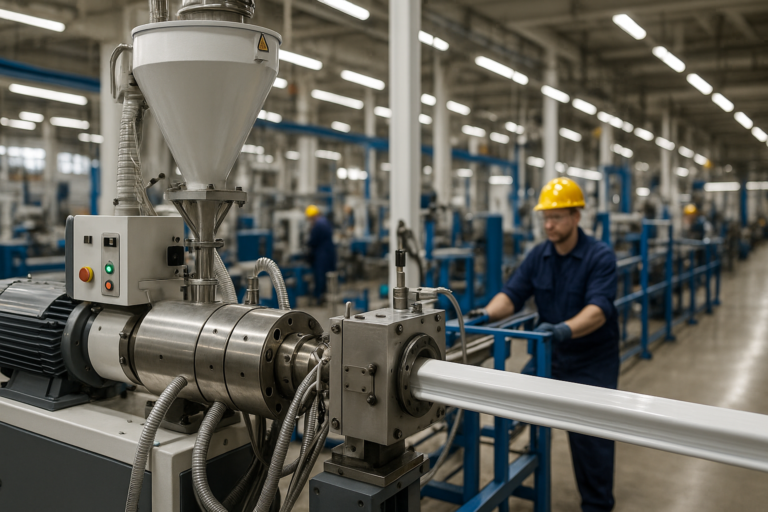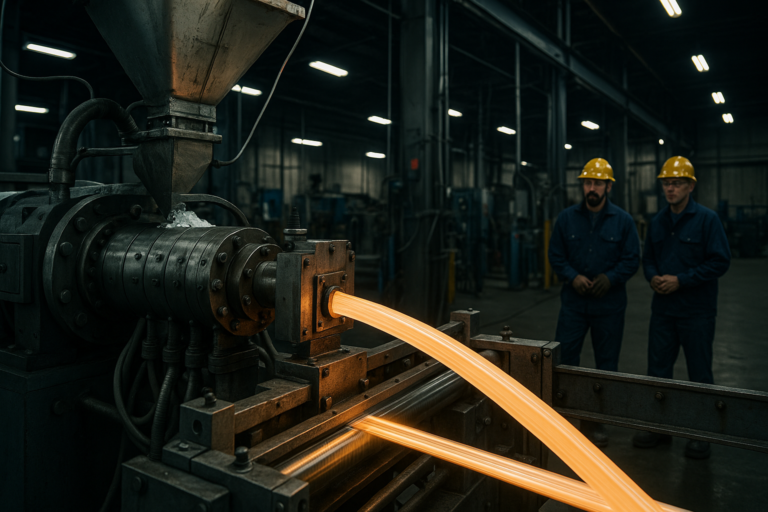Make some changes to the world environment
-
Building 3, Wanyang Innovation City, Langxia Street, Yuyao City, Zhejiang Province
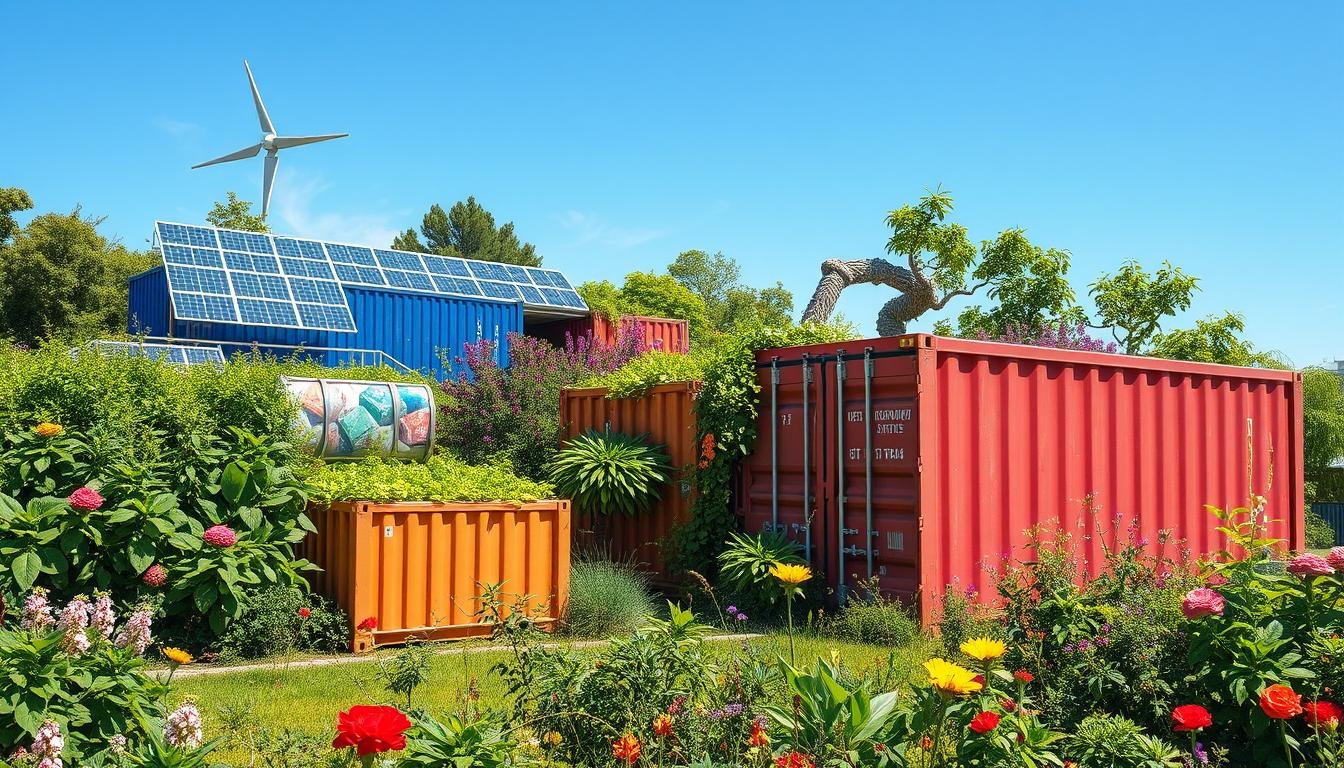
HDPE Plastic Recycling: Solutions for a Greener Future
Have you ever wondered how much impact recycling a single HDPE plastic bottle can have on our environment? The answer might surprise you. As we delve into the realm of sustainable plastic solutions, it’s crucial to understand the substantial role that HDPE plastic recycling plays in environmental sustainability in recycling. From conserving resources to minimizing waste, HDPE, with its extensive applications and resilient properties, stands at the forefront of revolutionizing HDPE waste management.
High-Density Polyethylene (HDPE) is not just another plastic; it is a material known for its robustness and versatility. Widely used in everyday items like bottles, containers, and pipes, HDPE’s properties, including its tensile strength of 20-40 MPa and density ranging from 0.93-0.97 g/cm³, make it an ideal candidate for recycling efforts1. But what exactly makes HDPE so special in the quest for greener solutions, and how can recycling it pave the way for a more sustainable future?
Key Takeaways
- HDPE plastic recycling significantly reduces environmental impact.
- The versatility and high demand for recycled HDPE pellets provide economic advantages.
- Recycling HDPE conserves energy by reducing the need for new plastic production.
- Advanced recycling techniques are essential for optimizing HDPE waste management.
- Consumers play a crucial role in supporting and promoting HDPE recycling efforts.
Understanding HDPE Plastic
High-density polyethylene (HDPE) is a versatile and robust plastic polymer highly valued in various industries due to its impressive durability and recyclability. To better comprehend the role and significance of HDPE, we must delve into its definition, inherent properties, and common applications.
What is HDPE?
HDPE, identified by the Resin Identification Code ‘2’, is known for its high strength-to-density ratio, making it a favored material in manufacturing and packaging sectors. This type of plastic, composed of ethylene monomers, is renowned for its capacity to withstand extreme conditions without degrading, which makes it an ideal candidate for various durable goods and packaging.
Properties of HDPE
The high-density polyethylene properties are crucial for understanding its wide range of applications. Typically, HDPE exhibits a density of 0.93-0.97 g/cm³, a melting point of 130-137°C, and tensile strength of 20-40 MPa, with an elongation at break between 100-1000%. Moreover, HDPE’s low leaching potential rates it amongst the safer plastics for food and beverage storage containers2. Another advantage is its potential for multiple recycling cycles, enhancing its sustainability3.
Common Uses of HDPE
HDPE applications span a multitude of products due to its adaptability and resilience. It is commonly used in manufacturing robust items such as bottles, containers, pipes, and automotive parts. These applications stem from its resistance to impact, moisture, and chemicals. Furthermore, its ability to be recycled multiple times without significant degradation reinforces its utility in promoting environmentally friendly practices3.
| Property | Value |
|---|---|
| Density | 0.93-0.97 g/cm³ |
| Melting Point | 130-137°C |
| Tensile Strength | 20-40 MPa |
| Elongation at Break | 100-1000% |
The Recycling Process of HDPE
Recycling HDPE plastic is an intricate process that begins with the collection and sorting of HDPE waste. These methods ensure that the materials are effectively separated and prepped for the various stages of recycling.
Collection and Sorting of HDPE Waste
The first step in the recycling process is HDPE waste sorting. This involves collecting discarded items such as bottles, bins, and shopping bags4. Advanced technologies like optical scanners are employed to identify and isolate HDPE materials from other types of plastics, ensuring that only the correct items proceed to the next stage. Such precision is vital as it prepares the waste for an efficient and contaminant-free recycling process5.
Cleaning and Shredding
Once sorted, the HDPE cleaning processes remove any contaminants and residual substances from the plastic materials4. Cleaned HDPE items are crucial to maintaining the integrity and quality of the recycled product. The cleaned HDPE is then shredded into uniform flakes, a step known as granulation, which is essential for creating a high-quality recycled material6.
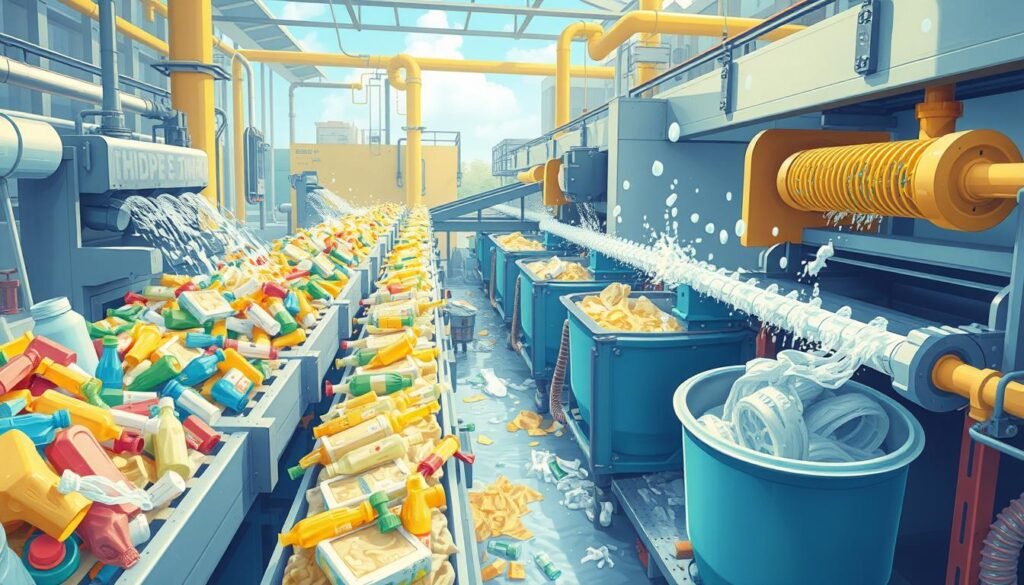
Extrusion and Remolding Techniques
The granulated HDPE is melted and extruded into pellets that serve as the raw material for new products. HDPE recycling methods often use techniques such as injection molding and blow molding to create new items from the recycled plastic6. This streamlined process not only preserves the value of the HDPE but also supports the creation of brand-new products like pipes, outdoor furniture, and household containers5.
By employing these methods, the recycling process maximizes the usability of HDPE, turning waste into valuable new products and contributing to environmental sustainability.
Benefits of HDPE Plastic Recycling
HDPE plastic recycling offers numerous advantages, ranging from environmental benefits to significant cost savings and energy efficiency for businesses. As we explore these benefits in detail, it becomes clear how recycling HDPE can contribute to a more sustainable future.
Environmental Impact and Sustainability
The environmental benefits of recycling HDPE are evident as it helps reduce the strain on power plants and oil reserves, minimizing pollution and the harmful effects of extraction7. By diverting HDPE plastics from landfills, we save energy, reduce overall energy consumption, and lessen the necessity for fossil fuels in producing new plastic products8. This sustainable practice has the potential to create a greener future, reflecting a significant opportunity for increased recycling efforts within the industry7.

Economic Advantages for Businesses
The economic impact of HDPE recycling for businesses is substantial. Manufacturing products from recycled HDPE plastic is less expensive than utilizing virgin plastic, leading to considerable cost savings8. Businesses engaging in HDPE recycling can also reduce their trash collection expenses, turning waste into a profitable resource by selling recyclables7. Additionally, partnerships with recycling companies can provide numerous benefits, including reduced staff workload, avoidance of penalties, protection from negative brand exposure, and improved public relations and employee morale7. The environmental impact of HDPE recycling can serve as a competitive advantage, attracting sustainability-conscious customers and enhancing revenue through better marketing and public relations7.
Energy Conservation Through Recycling
Energy efficiency in recycling HDPE is another pivotal benefit. Recycling HDPE can conserve up to twice as much energy compared to producing new plastics7. Recycling 10 HDPE plastic bottles saves enough energy to power a laptop for over 24 hours, underscoring this energy-saving potential7. Additionally, the recycling process for HDPE is more energy-efficient, conserving significant fossil fuels and energy8. This highlights the critical role of HDPE recycling in reducing energy consumption and supporting broader energy conservation initiatives.
Challenges in HDPE Recycling
Recycling HDPE presents a myriad of challenges that hinder the recycling process and reduce the quality of recycled products. These challenges span contamination issues, market fluctuations, and technological limitations, requiring innovative solutions and adaptive strategies.
Contamination Issues and Solutions
HDPE contamination issues significantly affect the quality of recycled materials. Contaminants such as non-HDPE plastics and other foreign substances can enter the recycling stream, leading to lower-grade recycled products. Advanced sorting and cleaning technologies play a vital role in addressing these contamination challenges. Proper collection and segregation of HDPE plastics ensure cleaner input for recycling, which maintains the integrity of the recycled material and facilitates its transformation into new products9. Cleaning and preparing HDPE materials before recycling helps mitigate contamination issues, paving the way for high-quality recycled HDPE9.
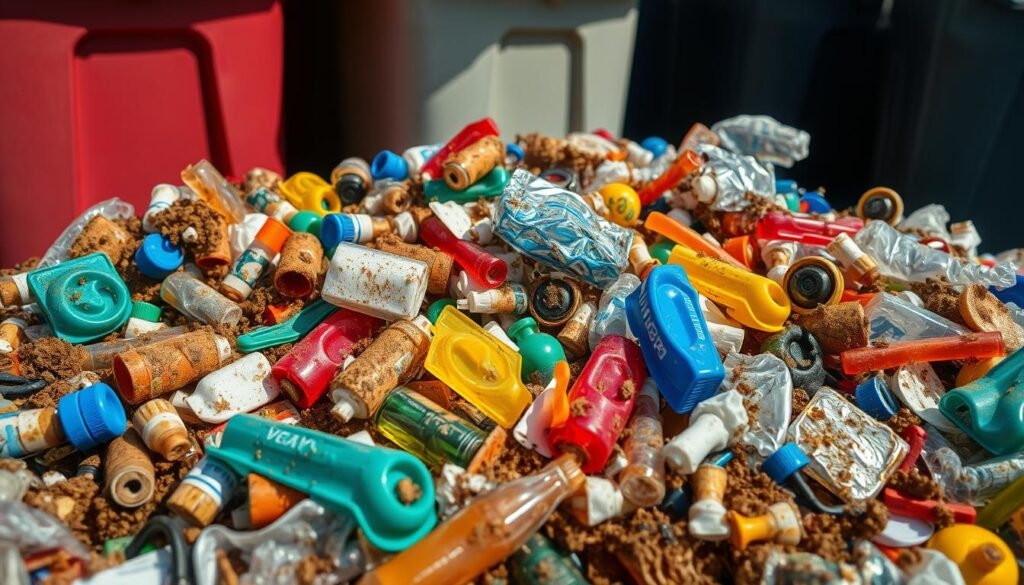
Market Fluctuations for Recycled HDPE
Market fluctuations represent another challenge in the recycled HDPE market trends. The pricing and demand for recycled HDPE can vary widely due to shifts in the prices of virgin plastics, changes in regulatory policies, and variations in consumer demand. For instance, around 4% of annual petroleum production is directly converted into plastics, making the market susceptible to changes in crude oil prices10. Businesses need to adopt adaptive strategies to navigate these fluctuations, ensuring they remain competitive despite market volatility10.
Technological Limitations in Processing
Technological advancements in HDPE recycling face several limitations, which can hinder processing efficiency and effectiveness. While mechanical recycling and energy recovery are key waste-management strategies in countries like those in the European Union, these methods have varying success rates across different regions10. Enhancing existing recycling technologies and investing in emerging approaches are essential to overcoming these limitations. For example, advances in sorting technologies are crucial in improving the efficiency and output quality of recycled HDPE9. Continuous innovation in this field is needed to address the technological hurdles in HDPE recycling and to drive further progress toward a sustainable and circular economy.
For more detailed information on the challenges and solutions in HDPE recycling, please visit this resource.
Innovations in HDPE Recycling Techniques
Recycling high-density polyethylene (HDPE) has seen remarkable advancements in recent years. These innovations aim to address the challenges of plastic waste management while striving for more efficient and environmentally friendly recycling processes. Key developments include HDPE sorting technology, chemical recycling of HDPE, and the emergence of sustainable alternatives to HDPE.
Advanced Sorting Technologies
Advanced sorting technologies have revolutionized the initial stages of HDPE recycling. By employing sophisticated artificial intelligence and robotics, these systems can identify and separate HDPE from other plastics with high precision. This enhancement significantly reduces contamination during sorting, leading to higher quality recycled HDPE products. Incidentally, North America leads in utilizing recycled HDPE for products like recycled plastic lumber and outdoor furniture, benefiting from these advanced sorting techniques11.
Chemical Recycling Processes
Chemical recycling processes such as pyrolysis and depolymerization have gained traction as efficient methods to break down HDPE into its monomers. This approach provides a cleaner feedstock for creating high-quality recycled products. For instance, pyrolysis and depolymerization have experienced rapid commercialization, despite the varying levels of energy required and differing environmental impacts12. Mechanical recycling, though industry-standard, often grapples with feedstock-specific limitations and contamination problems, underscoring the value of advanced methods like chemical recycling of HDPE12.
Biodegradable Alternatives
Research and development in biodegradable alternatives present promising sustainable solutions to traditional HDPE. Europe, driven by strict environmental regulations, has demonstrated innovation by using recycled HDPE in consumer goods continually11. These sustainable alternatives to HDPE could significantly diminish environmental impacts and collectively contribute to a greener planet. Embracing biodegradable alternatives could pave the way for more sustainable practices in HDPE recycling, positioning it as a game-changer in the industry.
For more comprehensive details, refer to our detailed analysis of the future of HDPE recycling.
The Role of Consumers in HDPE Recycling
Consumers play a vital role in enhancing the effectiveness of HDPE recycling programs. By adopting *eco-friendly practices*, we can significantly contribute to environmental sustainability. One of the essential steps is choosing products manufactured from recycled materials. This simple choice can reduce the demand for new plastic and lower the environmental impact. Additionally, proper sorting of waste at home ensures that HDPE products are efficiently recycled13.
Our daily habits influence the overall success of recycling programs. *Recycling education* programs are crucial as they help consumers understand the importance of recycling and how to do it correctly. Awareness about recycling symbols and procedures can improve participation rates and ensure that recyclable materials are not discarded as general waste. With approximately 6300 Mt of plastic waste generated up to 2015, of which only about 9% was recycled, the need for informed consumer actions is more critical than ever13.
In Brazil, for example, the recycling rates of plastic are alarmingly low, with only 4% of plastic being recycled13. This highlights the urgent need for better consumer involvement and responsibility in managing plastic waste. By minimizing the use of single-use plastics and opting for reusable items, consumers can significantly reduce the volume of waste that ends up in landfills and oceans. Effective *recycling education* and making eco-conscious choices are pivotal in creating a sustainable future.
Furthermore, engaging in local recycling programs and supporting businesses that prioritize sustainable practices can drive broader community impact. Companies like A-Pac Manufacturing are leading by example, incorporating up to 20% plant-based materials in their products and preventing plastic waste from ending up in landfills14. Such initiatives demonstrate the powerful role that consumer responsibility in recycling can play in fostering an environmentally friendly culture.
To summarize, our collective efforts in adopting *eco-friendly practices*, understanding and practicing *recycling education*, and being responsible consumers can significantly influence the success of HDPE recycling initiatives. By doing so, we can contribute to a healthier planet and a more sustainable future for coming generations.
Environmental Implications of HDPE Recycling
The environmental impact of recycling HDPE is multifaceted, showcasing both significant benefits and challenges. One undeniable advantage is the reduction in recycling energy consumption. The recycling process of HDPE consumes significantly less energy compared to the energy required for new plastic production, allowing us to save valuable resources and reduce overall emissions15. This energy-saving aspect is crucial for promoting sustainable practices in various industries that rely on HDPE plastic.
Energy Utilization
HDPE plastic can take centuries to decompose in nature, contributing to the accumulation of plastics in landfills and aquatic ecosystems15. Efficient recycling energy consumption practices can mitigate this problem by turning waste into reusable materials instead of allowing it to degrade slowly in the environment. Recycling one HDPE plastic bottle can save millions of pounds of plastic from occupying landfill space16, underscoring the crucial role that energy-efficient recycling processes play in waste management.
Chemical Contamination
While recycling HDPE offers numerous advantages, the process itself is not without potential issues, such as chemical contamination. During the collection and sorting stages, HDPE plastic waste may contain residual chemical pollutants that can contaminate the recycling stream if not adequately removed. Proper sorting and cleaning are essential components of effective HDPE plastic recycling to prevent such contamination15. Advancements in sorting technologies and rigorous cleaning protocols can significantly reduce the risk of chemical carryover, ensuring that recycled HDPE products maintain high-quality standards.
Greenhouse Gas Emissions
The emissions from HDPE recycling are another critical factor impacting the environment. While the energy savings achieved through the recycling process are substantial, transportation and processing stages still contribute to greenhouse gas emissions. The HDPE recycling process involves collecting and separating dirty and clean HDPE plastics, thorough cleaning, chipping into small pieces, forming into pellets, and combining with virgin HDPE plastics for improved reliability and strength16. Balancing the benefits of reducing waste with the necessity to minimize emissions from these operations remains a top priority for enhancing the sustainability of HDPE recycling.
To better understand these implications, let’s summarize how different aspects of HDPE recycling contribute to its environmental footprint:
| Aspect | Impact | Importance |
|---|---|---|
| Energy Utilization | Lower energy consumption compared to new plastic production | High |
| Chemical Contamination | Potential risk if not properly managed | Medium |
| Greenhouse Gas Emissions | Emissions from transportation and processing | High |
Conclusion
As we reflect on the advancements and challenges surrounding the recycling of HDPE plastics, it is evident that the future of HDPE recycling holds tremendous potential. The continuous evolution of techniques, such as improved cleaning and shredding processes, density separation in flotation tanks, and extrusion to create plastic granules, is key to producing high-quality recycled HDPE items17. These efforts not only contribute to plastic waste management but also emphasize sustainable development by fully leveraging the recyclability of HDPE materials17.
Despite the current limitations, like market fluctuations and contamination issues, the promising breakthroughs in advanced recycling technologies offer a glimpse into a sustainable future17. Comparatively, while only 9% of accumulated plastic is recycled in the United States, countries like India and South Korea demonstrate higher recycling rates at 60% and 45%, respectively18. Such statistics underscore the urgent need for our nation to adopt more efficient recycling practices.
Furthermore, the role of consumers in enhancing the recycling rates cannot be overstated. Public perception and behavior have a significant impact on the success of HDPE recycling initiatives and must be factored into strategies to address environmental challenges17. By fostering a collaborative global effort, encouraging consumer participation, and advancing recycling technologies, we can pave the way for a greener, more sustainable future in HDPE recycling.


